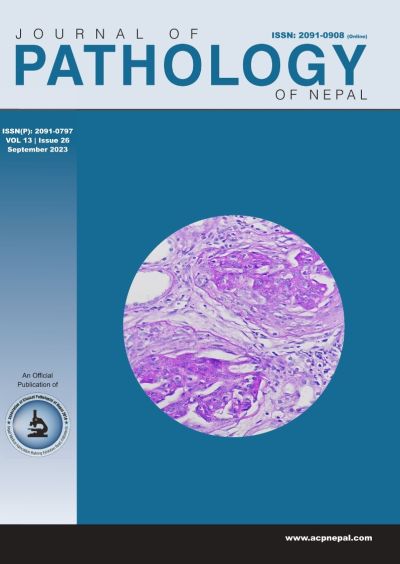Association of clinico-pathological and immunohistochemical prognostic parameters with presence of ductal carcinoma in-situ in an invasive ductal carcinoma of breast
DOI:
https://doi.org/10.3126/jpn.v13i2.53730Keywords:
Breast, DCIS, Ductal carcinoma, Immunohistochemistry, PrognosisAbstract
Background: The clinical outcome of breast carcinoma varies in each individual due to its molecular heterogeneity. There is a rising interest in whether the associated ductal carcinoma in-situ in invasive ductal carcinoma of breast affects the prognosis and overall survival of the patient. This study evaluates the difference in clinico-pathological and immunohistochemical prognostic factors between invasive ductal carcinoma with associated in-situ component, and invasive ductal carcinoma alone.
Materials and Methods: The study was conducted at a tertiary care hospital in South Tamilnadu, India. Two study groups were categorized based on the presence/absence of in-situ component in invasive ductal carcinoma of breast. Clinico-pathological variables and immunohistochemistry [Estrogen receptor (ER), Progesterone receptor (PR), HER2/neu and ki67] findings were compared between the two groups and statistical analysis was performed.
Results: There were 25 cases in each group. A significant statistical difference in tumor size was observed between invasive ductal carcinoma associated with in-situ component (mean-3.6cm) and without in-situ component (mean-5.0cm). A higher proliferative index (60%) was seen in invasive ductal carcinoma alone. There was no difference in the expression of Her2neu between the two groups. A proportionate increase in premenopausal population (60%) and hormone receptor positivity (ER, PR) was observed in invasive ductal carcinoma associated with in-situ component.
Conclusions: Invasive ductal carcinoma associated with ductal carcinoma in-situ shows a less aggressive behaviour compared to invasive carcinoma alone. Further studies of a larger scale need to be done which might help in identifying the subgroup for targeted therapy.
Downloads
Downloads
Published
How to Cite
Issue
Section
License
Copyright (c) 2023 The Author(s)

This work is licensed under a Creative Commons Attribution 4.0 International License.
This license enables reusers to distribute, remix, adapt, and build upon the material in any medium or format, so long as attribution is given to the creator. The license allows for commercial use.




